Lawn & Garden
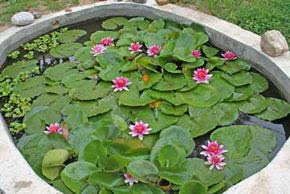
Setting up a water garden pond is simpler than you think. Take a look at some popular garden images.
Constructing a water garden pond on your own is not as hard as you might imagine. With the availability of two alternatives to traditional pools, which are flexible liners and prefabricated pools, setting up a water garden pond is not solely for professionals anymore.
This article provides all the essential information you need to kick off your own water garden pond, including useful tips, how to install a flexible liner and a prefabricated liner, how to build a waterfall, how to select a pump for a waterfall, and how to construct a waterfall with a flexible liner.
Popular Garden Images
In the following article, you will learn about tips for installing your own water garden pond, including making liner choices and calculating the appropriate measurements for installation.
Need More Information on Water Gardens? Check Out These:
- How to Build a Water Garden: Read through advice and tips for creating your water garden.
- Water Garden Plants: Explore various plant options for your water garden.
- Water Gardens: Find out everything you need to know to start your own water garden.
- Gardening: Learn the fundamental principles of successful gardening.
Easy Steps for Installing Your Water Garden Pond
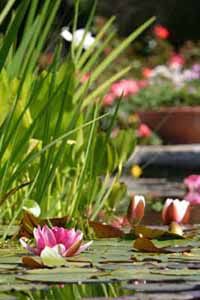
You can construct a water garden pond without hiring professionals.
Nowadays, many people choose to set up their own garden pools. If you prefer this option, there are two primary alternatives: flexible liners and prefabricated pools. Both are cost-effective and can be installed by two people in a single weekend. Concrete pools are more expensive and require greater skills, so it is best to contact a professional landscaper for planning and construction.
The pool surface must be levelled perfectly (one edge can be slightly lower to permit rainwater drainage). If your yard is on a slope, you may need to dig deeper at the higher end or even fortify the lower one to achieve the preferred effect. Use a level throughout the installation procedure to ensure your pool remains levelled. Installing a flexible liner is the easiest and most economical process for the non-specialist. Ensure to use a liner specifically designed for water gardens, not just any plastic sheet. Currently, PVC liners are the most popular; dark shades offer the most natural effect. The thicker the liner, the more extended it will last, and the more it will cost. Since light degrades plastic, search for liners with enhanced UV protection, particularly if your pond is shallow. Rubber liners are the most durable but also the most expensive.
To calculate the appropriate size for your liner, measure the width and length of the intended pool at the widest points, add twice the pool’s depth, and then add an extra foot for overlap. For instance, a pool that is 10 feet long, 6 feet wide, and 2 feet deep will require a liner that is 15 feet long (10 + (2 x 2) + 1) and 11 feet wide (6 + (2 x 2) + 1).
Read on to learn about installing a flexible liner for your water garden pond.
Need more information on water gardens? Here are some options:
- How to Build a Water Garden: Get helpful tips and advice on creating your own water garden.
- Water Garden Plants: Discover the different types of plants that can be used in a water garden.
- Water Gardens: Learn everything you need to know to start your own water garden.
- Gardening: Get familiar with the basics of successful gardening.
How to Install a Flexible Liner for a Water Garden Pond

The first step is outlining the pool.
For home gardeners, the easiest and most cost-effective way to install a liner is by using a flexible liner. The following step-by-step instructions will help you complete the process successfully.
1. Use a piece of garden hose to outline the pool. If the pool is rectangular or square, use string that is carefully staked in place to create the outline. A framing square will be needed to create a 90-degree angle at the corners.
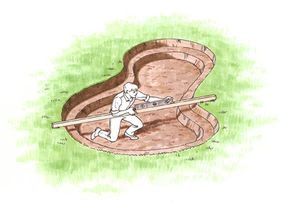
Use a straight board while digging out the pond.
2. Dig out the pond to a depth that is two inches deeper than the desired depth. Leave shelves that are approximately 6 to 18 inches (with 9 inches being the average) deep in areas where you plan to place emergent plants, such as cattails. The edges should not be cut perfectly perpendicular or they may collapse. A slight angle, about 20 degrees, is best. Use a straight board with a level to ensure that the pond’s edge is perfectly level. If you are edging your pond with field stone, remove an additional layer of sod from the edges so that the stones can be placed evenly with the surrounding soil.

Line the pond area with damp sand.
3. Remove any debris, such as stones or sticks, from the pool bottom and sides. Then, line the entire surface with two inches of damp sand. You may want to install a piece of landscape fabric over the sand for additional protection against piercing, especially if you are using a lower-grade liner.

Use stones to keep the liner in place.
4. Carefully spread the liner over the excavation, folding it at the corners or curves. Mold the liner to the hole by using your feet (remove your shoes first). Use stones to hold the liner in place.
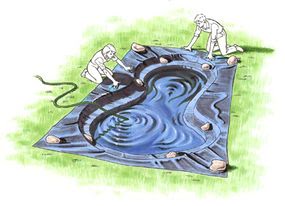
Smooth out wrinkles as you fill the pool with water.
5. Add water slowly, smoothing out any wrinkles as the pool fills up.

Cover the liner overlap with soil or paving stones.
6. Trim any excess liner, leaving six inches of liner overlapping at all points. Cover the overlap with soil or paving stones.
Continue reading to learn about installing a prefabricated liner for a water garden pond.
Need more information about water gardens? Check out these resources:
- How to Build a Water Garden: This guide offers tips and advice for building your own water garden.
- Water Garden Plants: Explore the different plants that can thrive in your water garden.
- Water Gardens: Learn everything you need to know to get started on your own water garden.
- Gardening: Master the basics of successful gardening.
How to Install a Prefabricated Liner for Your Water Garden Pond

Make sure the final hole matches the shape of the liner.
If you’re a gardener who wants to install a water garden pond without professional help, installing a prefabricated liner is a great option. Follow these step-by-step instructions to get started:
1. Use a garden hose to outline the pool’s position. Dig out the hole two inches wider and deeper than the required depth, taking into account any built-in shelves. The final excavation should match the shape of the liner.

Place the shell on top of two inches of wet sand.
2. Line the excavation with two inches of wet sand, making sure the base is level. Place the shell in the hole.

Add stones around the edges of the liner if desired.
3. Slowly add water, filling in the area around the shell with sand as you go. Add edging if desired.
Keep reading to learn how to build a waterfall for your water garden pond.
Need more information about water gardens? Check out these resources:
- How to Build a Water Garden: This guide offers tips and advice for building your own water garden.
- Water Garden Plants: Explore the different plants that can thrive in your water garden.
- Water Gardens: Learn everything you need to know to get started on your own water garden.
- Gardening: Master the basics of successful gardening.
How to Build a Waterfall for Your Water Garden Pond

There are many types of water pumps available for water gardens.
Moving water isn’t a requirement for a water garden; in fact, aquatic plants grow best in still water. However, adding a waterfall or fountain has several benefits. Moving water is better aerated than still water, which is great for fish. A filter can be easily added to any pump to make the water clearer. But the main reason for including a pump in your water garden is aesthetic: People love the sound and sight of moving water.
Be careful not to create strong currents or excessive splashing near aquatic plants, or they can be damaged. Fountains are especially harmful to plant life, as their spray can reach considerable distances under strong winds. Waterfalls can usually be separated from water lilies and other plants by placing the cascade at one end of the pool and installing a few well-placed rocks to diffuse the current.
Choose the form of moving water that best suits your pool. Fountains and other ornaments work best for formal pools, while waterfalls cascading over rocks work well for irregular pools in natural settings. Simple underwater filter systems are suitable for any type of pool.
When it comes to fountains, there are many options available such as cones, sprays, jets, and bubble effects. You can even fit pipe heads to ornamental statues, ceramic jars, or bamboo pipes. However, it’s important to make sure that the height of the spray doesn’t exceed half the diameter of the pond, as this can result in water being sprayed out during windy periods.
If you have a natural slope in your yard, consider installing a waterfall to blend your water garden into the rest of the landscape. Waterfalls can also be used in flat areas but can stick out if not placed carefully. You can place tall plants or a fence behind the waterfall to resolve this issue. Combining rock gardens and waterfalls is an excellent idea since the waterfall is naturally set off by rocks, and rock garden plants won’t block the resulting stream’s view.
You can buy prefabricated waterfall units, which are easy to install. They may consist of an entirely preformed section with several tiers or individual catch basins designed to be placed slightly overhanging the previous one. You also have the option of making your waterfall using a section or sections of flexible liner.
There are various pumps available for water gardens, and you should choose one based on the amount of water to be moved, the distance to be covered, and the height to be pushed. It’s recommended that you select a somewhat stronger pump than your needs, just in case. The pump’s rate of flow per hour should not be greater than the pond’s capacity, but it should be able to circulate nearly half the pool’s water per hour. To estimate your pool’s volume, multiply its length by its width by its depth (in inches) and divide this by 231 to obtain the number of gallons.
Water filters are not essential for a healthy pond, but they help keep the water clear and free of debris. Mechanical filters are the most popular and require regular cleaning or filter replacement. Biological filters take up more space, but they need little upkeep.
Continue reading to discover how to select a pump for a waterfall.
Need more details about water gardens? These resources can help:
- How to Construct a Water Garden: Discover tips and guidance for constructing your own water garden.
- Water Garden Plants: Examine the various plants that are suitable for water gardens.
- Water Gardens: Get all the information you need to start your own water garden.
- Gardening: Master the fundamental principles of successful gardening.
Choosing a Pump for a Waterfall

Submersible pumps are frequently used in water garden ponds.
The most commonly used type of pump is a submersible pump, which can be submerged underwater and out of sight. A 24-volt pump may be sufficient for small ponds, while larger ones typically use a standard 110-volt house current. If there is no electrical outlet near the pond, an electrician should be hired to install one. Any underground wiring should be placed at least 18 inches deep and run through PVC piping to avoid accidental breakage. A ground fault circuit interrupter is recommended in all cases.
Continue reading to learn how to construct a waterfall using a flexible liner.
Need more details about water gardens? These resources can help:
- How to Construct a Water Garden: Discover tips and guidance for constructing your own water garden.
- Water Garden Plants: Examine the various plants that are suitable for water gardens.
- Water Gardens: Get all the information you need to start your own water garden.
- Gardening: Master the fundamental principles of successful gardening.
Constructing a Waterfall with a Flexible Liner
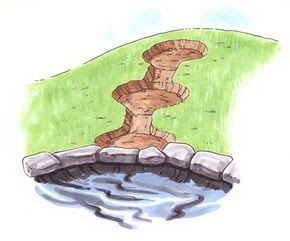
Step 1
Flexible liners that are available to home gardeners are not only suitable for building garden ponds, but also for constructing waterfalls. Follow the step-by-step instructions below to get started.
1. Dig out individual basins.

Step 2
2. Cover excavation with flexible liner.
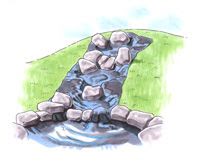
Step 3
3. Use rocks to conceal liner and edges.
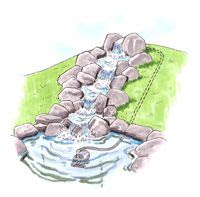
Step 4
4. Install pump and add water.
Need more details about water gardens? These resources can help:
- How to Construct a Water Garden: Discover tips and guidance for constructing your own water garden.
- Water Garden Plants: Examine the various plants that are suitable for water gardens.
- Water Gardens: Get all the information you need to start your own water garden.
- Gardening: Master the fundamental principles of successful gardening.
FAQ
1. What is a water garden pond?
A water garden pond is a man-made water feature that is designed to mimic the natural ecosystem of a pond. It is typically constructed using a liner and is filled with aquatic plants and fish. Water garden ponds can range in size from small patio ponds to large backyard ponds that can hold thousands of gallons of water. They are a great way to add beauty and tranquility to your outdoor space.
2. What are the benefits of having a water garden pond?
There are many benefits to having a water garden pond. Firstly, they are a great way to add beauty and tranquility to your outdoor space. They can also help to attract wildlife such as birds, butterflies, and dragonflies to your yard. Additionally, water garden ponds can help to improve the quality of the air by releasing oxygen and removing carbon dioxide. Lastly, they can help to improve the overall health of your yard by providing a natural filtration system that helps to remove excess nutrients from the soil.
3. What materials do I need to install a water garden pond?
You will need a few essential materials to install a water garden pond. These include a pond liner, a pump, a filter, and aquatic plants and fish. You may also need additional materials such as rocks, gravel, and a skimmer. Before purchasing any materials, it is important to determine the size and location of your pond and to consult with a professional if necessary.
4. How do I prepare the site for a water garden pond?
The first step in preparing the site for a water garden pond is to choose a location that receives at least six hours of sunlight per day. Once you have chosen a location, you will need to dig a hole that is slightly larger than the size of your pond liner. It is important to level the ground and remove any sharp objects or debris from the site. You may also want to add a layer of sand or underlayment to protect the pond liner from punctures.
5. How do I install the water garden pond?
Once you have prepared the site, you can begin to install the water garden pond. First, lay the pond liner in the hole and smooth out any wrinkles or folds. Next, install the pump and filter according to the manufacturer’s instructions. You can then fill the pond with water and add rocks, gravel, and aquatic plants to create a natural-looking environment. Finally, you can add fish to the pond, being careful not to overcrowd the ecosystem.
6. How do I maintain my water garden pond?
Maintaining a water garden pond is relatively simple. You will need to regularly check the water levels and adjust the pump and filter as needed. You may also need to remove any debris or dead leaves from the pond to prevent clogging. It is important to test the water regularly to ensure that the pH and nutrient levels are balanced. Additionally, you may need to add beneficial bacteria or algae control products to keep the pond healthy and clear.

Brody is a skilled craftsman and gardening expert. From renovating living spaces to cultivating lush gardens, Brody’s knowledge and passion shine through, inspiring readers to embark on their own home improvement and gardening journeys with confidence.






Leave a Reply